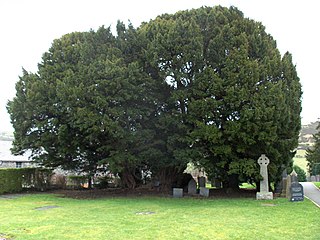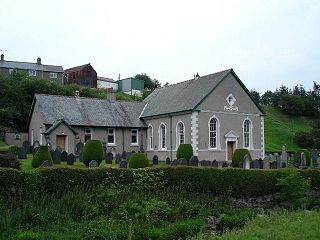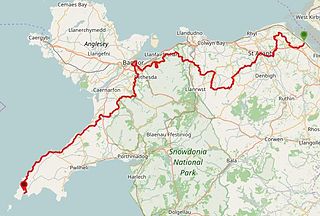Digain | |
|---|---|
| Born | 429 AD |
| Died | Late 5th century |
| Honored in | Roman Catholic Church Eastern Orthodox Church |
Digain (also known as Dygain) was a 5th-century Welsh saint and Prince of Dumnonia (now the English West Country).
Contents

Digain | |
|---|---|
| Born | 429 AD |
| Died | Late 5th century |
| Honored in | Roman Catholic Church Eastern Orthodox Church |
Digain (also known as Dygain) was a 5th-century Welsh saint and Prince of Dumnonia (now the English West Country).

Digain ap Constantine was said to be the son of Constantine Corneu, King of Dumnonia, and was born in c.429[ citation needed ] He was believed to have had three brothers, Erbin (also sainted), Meirchion and Drustan, and possibly a sister (of unknown name).[ citation needed ]
Traditionally St Digain founded the church of that name in Llangernyw, meaning "the church of the Cornishman", in the county of Conwy in Wales. [1] The church was sited next to an already venerable yew, the Llangernyw yew. His sainthood was due being a confessor, meaning he was of remarkable virtue and confessed of the faith through writings and preachings, and has the feast day of November 21. [2]

Petroc or Petrock was a British prince and Christian saint.
Constantine was a 6th-century king of Dumnonia in sub-Roman Britain, who was remembered in later British tradition as a legendary King of Britain. The only contemporary information about him comes from Gildas, who castigated him for various sins, including the murder of two "royal youths" inside a church. The historical Constantine is also known from the genealogies of the Dumnonian kings, and possibly inspired the tradition of Saint Constantine, a king-turned-monk venerated in southwest Britain and elsewhere.

Llanddoged is a small village which lies in the hills a little over a mile to the north of Llanrwst, in Conwy county borough, Wales. The village itself has a small population, with a surrounding rural farming community. Most of the population are Welsh speakers. Llanddoged shares its community council with the rural community of Maenan. Llanddoged has two small hamlets attached to it - Groesffordd and Tan-Lan. Groesffordd has a motor repair garage known as 'Garej Groesffordd'. Tan-lan was known for its notorious bends on the A470 where, before road improvements, many road traffic collisions had occurred. Tan-lan is also home to an Environment Agency Wales depot.

St Just, also known as St Just in Penwith, is a town and civil parish in the Penwith district of Cornwall, England, United Kingdom. It lies along the B3306 road which connects St Ives to the A30 road. The parish encompasses the town of St Just and the nearby settlements of Trewellard, Pendeen and Kelynack: it is bounded by the parishes of Morvah to the north-east, Sancreed and Madron to the east, St Buryan and Sennen to the south and by the sea in the west. The parish consists of 7,622 acres (3,085 ha) of land, 12 acres (4.9 ha) of water and 117 acres (47.3 ha) of foreshore. The town of St Just is the most westerly town in mainland Britain and is situated approximately 8 miles (13 km) west of Penzance along the A3071. St Just parish, which includes Pendeen and the surrounding area, has a population of 4,637. An electoral ward of the same name also exists: the population of this ward at the same census was 4,812.

The Diocese of Saint Asaph is a diocese of the Church in Wales in north-east Wales, named after Saint Asaph, its second bishop.

Taxus baccata is a species of evergreen tree in the family Taxaceae, native to Western Europe, Central Europe and Southern Europe, as well as Northwest Africa, northern Iran, and Southwest Asia. It is the tree originally known as yew, though with other related trees becoming known, it may be referred to as common yew, European yew, or in North America English yew. It is a woodland tree in its native range, and is also grown as an ornamental tree, hedge or topiary. The plant is poisonous, with toxins that can be absorbed through inhalation, ingestion, and transpiration through the skin. Consuming any part of the tree, excluding the aril, can be deadly and the consumption of even a small amount of the foliage can result in death.

Llangernyw ( ) is a rural, mostly Welsh-speaking, village and community in Conwy County Borough, North Wales.

November 20 - Eastern Orthodox liturgical calendar - November 22

Llangelynnin is a former parish in the Conwy valley, in Conwy county borough, north Wales. Today the name exists only in connection with the church, a school in the nearby village of Henryd, and the nearby mountain ridge, Craig Celynnin.
Erbin of Dumnonia was a 5th-century King of Dumnonia and saint of Wales.
Constantine was reputedly the son and successor of King Riderch Hael of Alt Clut, the Brittonic kingdom later known as Strathclyde. He appears only in the Life of St. Kentigern by Jocelyn of Furness, which regards him as a cleric, thus connecting him with the several obscure saints named Constantine venerated throughout Britain.

Pandy Tudur is a village in Conwy county borough, in the north-west of Wales. It lies 5 miles northeast of Llanrwst.
Llan and its variants are a common element of Celtic placenames in the British Isles and Brittany, especially of Welsh toponymy. In Welsh the name of a local saint or a geomorphological description follows the Llan morpheme to form a single word: for example Llanfair is the parish or settlement around the church of St. Mair. Goidelic toponyms end in -lann.

Charles Clutterbuck (1806–1861) was an English stained glass artist of the early Victorian era, being a younger contemporary of Thomas Willement and William Warrington
Saint Constantine is the name of one or many British or Pictish saints.

The Llangernyw Yew ( ) is an ancient yew in the village of Llangernyw, Conwy, Wales. The tree is fragmented and its core part has been lost, leaving several enormous offshoots. The girth of the tree at the ground level is 10.75 m (35.3 ft).
Patapios of Thebes is the patron saint of dropsy. Saint Patapios’ memory is celebrated on 8 December and also at the Tuesday 2 days after the Sunday of Easter. His relic is kept at the female monastery of Saint Patapios at Loutraki, a spa town near Athens, Greece.
The Catholic Church recognizes the individuals of Lucius, Absalom, and Lorgius as Saints due to their recorded suffering and death in Caesarea, a location within Cappadocia. St. Lucius is thought to have been a bishop of Spanish heritage. Unfortunately, little is known about these Christian martyrs, with even their names being uncertain, although they are commemorated during the holy calendar day of March 2.

The North Wales Pilgrim's Way is a long-distance walking route in North Wales, running from near Holywell in the east to Bardsey Island in the west. The first half of the trail takes an inland route, with the second half following the north coast of the Llŷn Peninsula. It measures 133.9 miles (215 km) in length, and was officially launched at Porth y Swnt, Aberdaron on 10 July 2014.